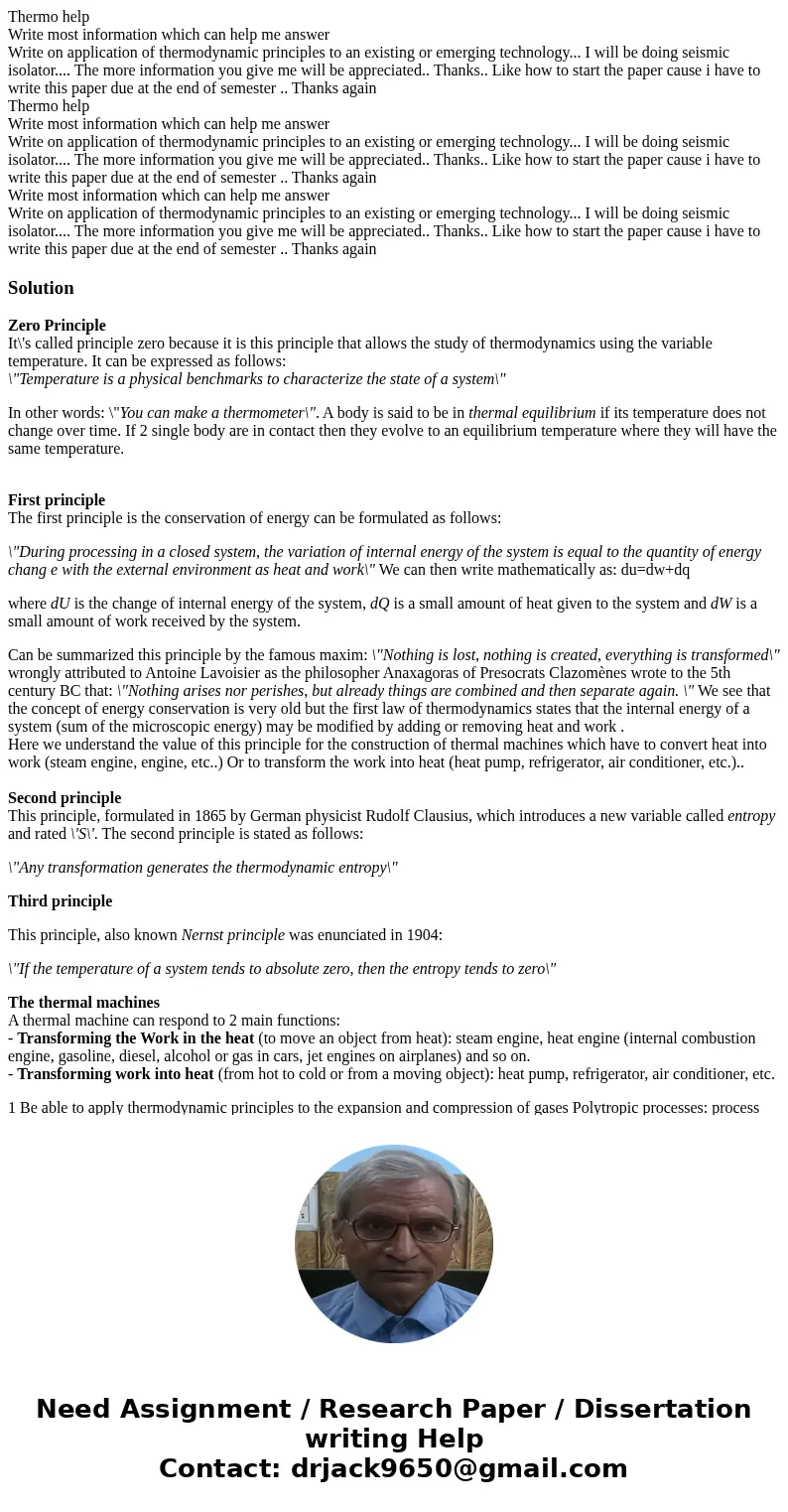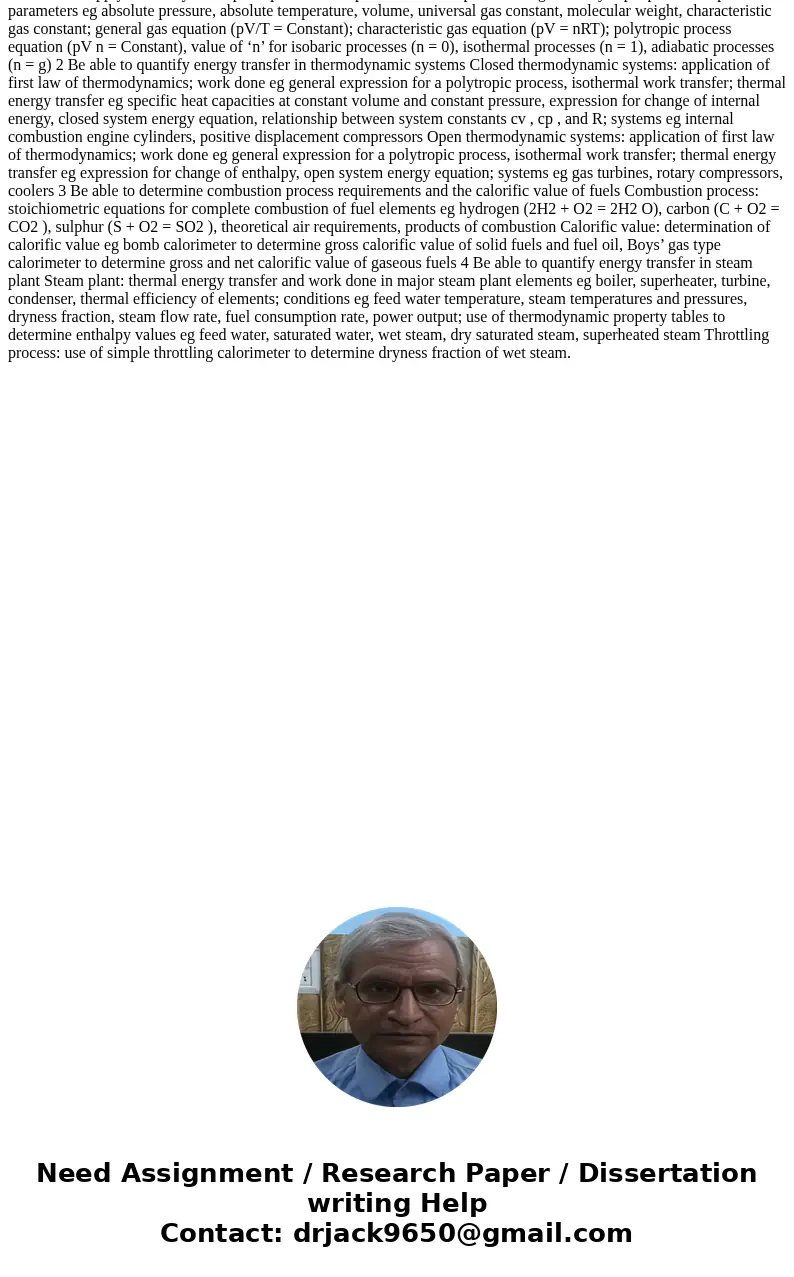Thermo help Write most information which can help me answer
Solution
Zero Principle
It\'s called principle zero because it is this principle that allows the study of thermodynamics using the variable temperature. It can be expressed as follows:
\"Temperature is a physical benchmarks to characterize the state of a system\"
In other words: \"You can make a thermometer\". A body is said to be in thermal equilibrium if its temperature does not change over time. If 2 single body are in contact then they evolve to an equilibrium temperature where they will have the same temperature.
First principle
The first principle is the conservation of energy can be formulated as follows:
\"During processing in a closed system, the variation of internal energy of the system is equal to the quantity of energy chang e with the external environment as heat and work\" We can then write mathematically as: du=dw+dq
where dU is the change of internal energy of the system, dQ is a small amount of heat given to the system and dW is a small amount of work received by the system.
Can be summarized this principle by the famous maxim: \"Nothing is lost, nothing is created, everything is transformed\" wrongly attributed to Antoine Lavoisier as the philosopher Anaxagoras of Presocrats Clazomènes wrote to the 5th century BC that: \"Nothing arises nor perishes, but already things are combined and then separate again. \" We see that the concept of energy conservation is very old but the first law of thermodynamics states that the internal energy of a system (sum of the microscopic energy) may be modified by adding or removing heat and work .
Here we understand the value of this principle for the construction of thermal machines which have to convert heat into work (steam engine, engine, etc..) Or to transform the work into heat (heat pump, refrigerator, air conditioner, etc.)..
Second principle
This principle, formulated in 1865 by German physicist Rudolf Clausius, which introduces a new variable called entropy and rated \'S\'. The second principle is stated as follows:
\"Any transformation generates the thermodynamic entropy\"
Third principle
This principle, also known Nernst principle was enunciated in 1904:
\"If the temperature of a system tends to absolute zero, then the entropy tends to zero\"
The thermal machines
A thermal machine can respond to 2 main functions:
- Transforming the Work in the heat (to move an object from heat): steam engine, heat engine (internal combustion engine, gasoline, diesel, alcohol or gas in cars, jet engines on airplanes) and so on.
- Transforming work into heat (from hot to cold or from a moving object): heat pump, refrigerator, air conditioner, etc.
1 Be able to apply thermodynamic principles to the expansion and compression of gases Polytropic processes: process parameters eg absolute pressure, absolute temperature, volume, universal gas constant, molecular weight, characteristic gas constant; general gas equation (pV/T = Constant); characteristic gas equation (pV = nRT); polytropic process equation (pV n = Constant), value of ‘n’ for isobaric processes (n = 0), isothermal processes (n = 1), adiabatic processes (n = g) 2 Be able to quantify energy transfer in thermodynamic systems Closed thermodynamic systems: application of first law of thermodynamics; work done eg general expression for a polytropic process, isothermal work transfer; thermal energy transfer eg specific heat capacities at constant volume and constant pressure, expression for change of internal energy, closed system energy equation, relationship between system constants cv , cp , and R; systems eg internal combustion engine cylinders, positive displacement compressors Open thermodynamic systems: application of first law of thermodynamics; work done eg general expression for a polytropic process, isothermal work transfer; thermal energy transfer eg expression for change of enthalpy, open system energy equation; systems eg gas turbines, rotary compressors, coolers 3 Be able to determine combustion process requirements and the calorific value of fuels Combustion process: stoichiometric equations for complete combustion of fuel elements eg hydrogen (2H2 + O2 = 2H2 O), carbon (C + O2 = CO2 ), sulphur (S + O2 = SO2 ), theoretical air requirements, products of combustion Calorific value: determination of calorific value eg bomb calorimeter to determine gross calorific value of solid fuels and fuel oil, Boys’ gas type calorimeter to determine gross and net calorific value of gaseous fuels 4 Be able to quantify energy transfer in steam plant Steam plant: thermal energy transfer and work done in major steam plant elements eg boiler, superheater, turbine, condenser, thermal efficiency of elements; conditions eg feed water temperature, steam temperatures and pressures, dryness fraction, steam flow rate, fuel consumption rate, power output; use of thermodynamic property tables to determine enthalpy values eg feed water, saturated water, wet steam, dry saturated steam, superheated steam Throttling process: use of simple throttling calorimeter to determine dryness fraction of wet steam.


 Homework Sourse
Homework Sourse